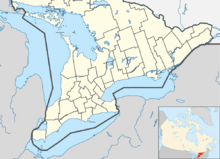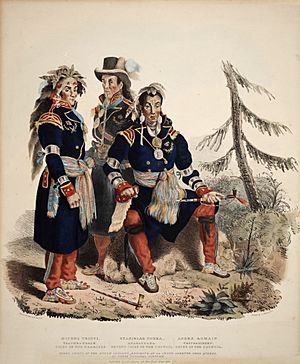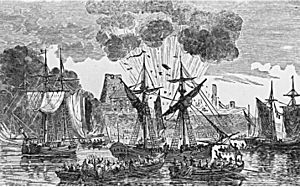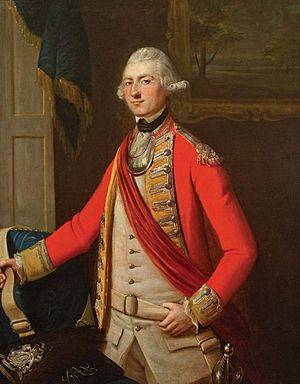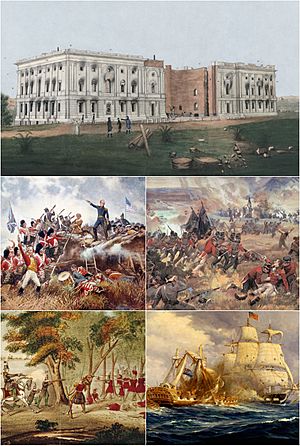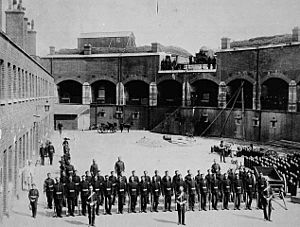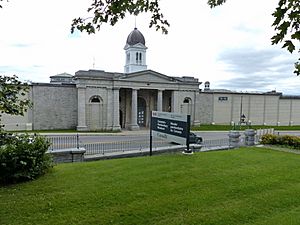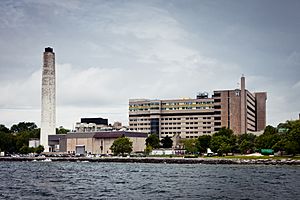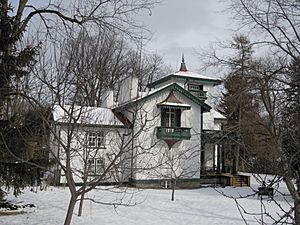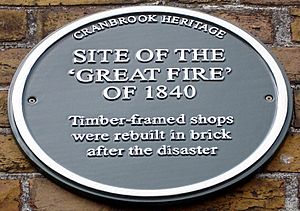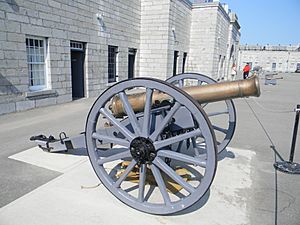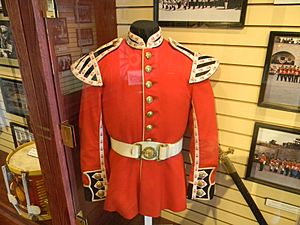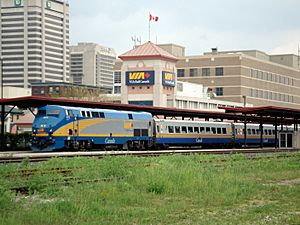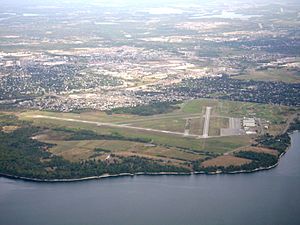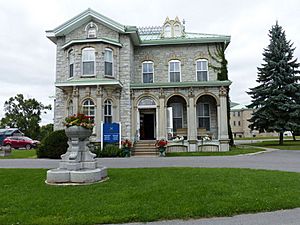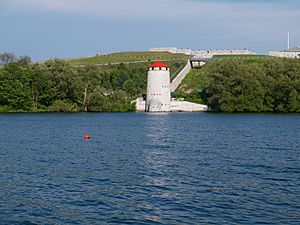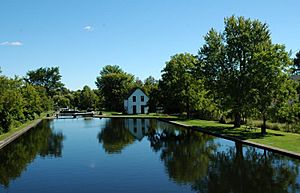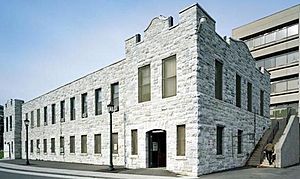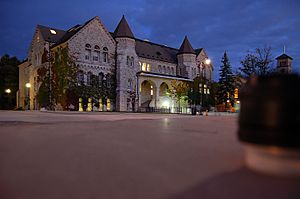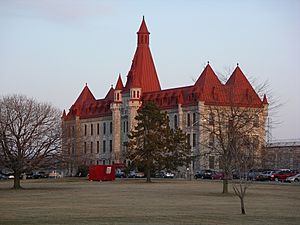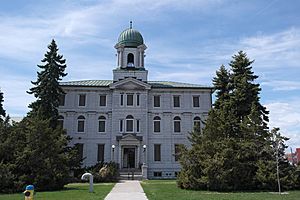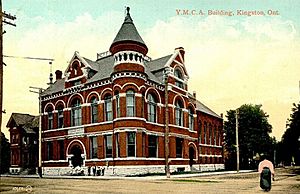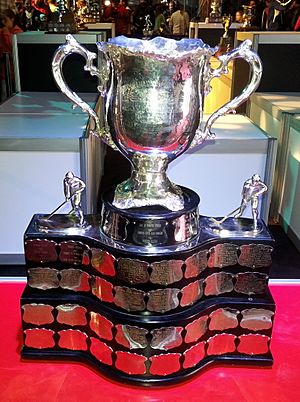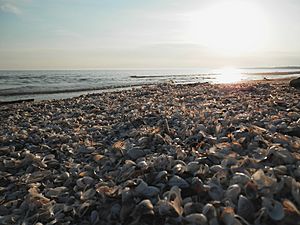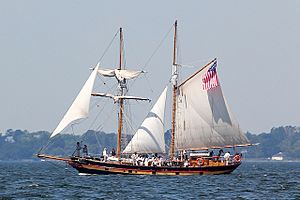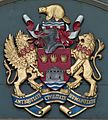Kingston, Ontario facts for kids
Quick facts for kids
Kingston
|
||
|---|---|---|
| City of Kingston | ||

Kingston City Skyline from Fort Henry Hill
|
||
|
||
| Nickname(s):
Limestone City
|
||
| Motto(s):
"A Civil And Creative Community with a Proud Past"
|
||
| Country | Canada | |
| Province | Ontario | |
| County | Frontenac | |
| Established | 1673 (as Fort Cataraqui; later renamed Fort Frontenac) | |
| Incorporated | 1838 (as town); 1846 (as city) | |
| Amalgamated | 1998 (with Kingston and Pittsburgh Twps) | |
| Area | ||
| • Land | 451.19 km2 (174.21 sq mi) | |
| • Metro | 1,906.82 km2 (736.23 sq mi) | |
| Elevation | 93 m (305 ft) | |
| Population
(2016)
|
||
| • City | 123,798 | |
| • Density | 274.4/km2 (711/sq mi) | |
| • Metro | 161,175 | |
| • Metro density | 83.1/km2 (215/sq mi) | |
| source: | ||
| Time zone | UTC−5 (Eastern (EST)) | |
| • Summer (DST) | UTC−4 (Eastern (EDT)) | |
| Postal code span |
K7K through K7P
|
|
| Area code(s) | 613 343 | |
| Website | www.cityofkingston.ca | |
Kingston is a city in Eastern Ontario, Canada. It is on the eastern end of Lake Ontario, at the beginning of the St. Lawrence River and at the mouth of the Cataraqui River (south end of the Rideau Canal). The city is midway between Toronto, Ontario and Montreal, Quebec. The Thousand Islands tourist region is nearby to the east. Kingston is nicknamed the "Limestone City" because of the many heritage buildings constructed using local limestone.
Growing European exploration in the 17th century and the desire for the Europeans to establish a presence close to local Native occupants to control trade led to the founding of a French trading post and military fort at a site known as "Cataraqui" in 1673. This outpost, called Fort Cataraqui, and later Fort Frontenac, became a focus for settlement. Cataraqui would be renamed Kingston after the British took possession of the fort and Loyalists began settling the region in the 1780s.
Kingston was named the first capital of the United Province of Canada on February 10, 1841. While its time as a capital city was short (ending in 1844), the community has remained an important military installation. Kingston was the county seat of Frontenac County until 1998. Kingston is now a separate municipality from the County of Frontenac.
Contents
History
Archaeological evidence suggests people lived in the Kingston region as early as the Archaic Period (about 9,000–3,000 years ago). Evidence of Late Woodland Period (about 1000–500 AD) early Iroquois occupation also exists. The first more permanent encampments by aboriginal people in the Kingston area began about 500 AD. The group that first occupied the area before the arrival of the French was probably the Wyandot people (Hurons), who were later displaced by Iroquoian groups.
At the time the French arrived in the Kingston area, Five Nations Iroquois (Haudenosaunee) had settled along the north shore of Lake Ontario. Although the area around the south end of the Cataraqui River was often visited by Iroquois and other groups, Iroquois settlement at this location only began after the French established their outpost. By 1700, the north shore Iroquois had moved south, and the area once occupied by the Iroquois (which includes Kingston) became occupied by the Mississaugas who had moved south from the Lake Huron and Lake Simcoe regions.
European commercial and military influence and activities centred on the fur trade developed and increased in North America in the 17th century. Fur trappers and traders were spreading out from their centres of operation in New France.
To establish a presence on Lake Ontario for the purpose of controlling the fur trade with local indigenous people, Louis de Buade de Frontenac, Governor of New France established Fort Cataraqui, later to be called Fort Frontenac, at a location known as Cataraqui in 1673. The fort served as a trading post and military base, and gradually attracted indigenous and European settlement. In 1674, René-Robert Cavelier, Sieur de La Salle was appointed commandant of the fort. From this base, de La Salle explored west and south as far as the Gulf of Mexico.
The fort was rebuilt several times and experienced periods of abandonment. The Iroquois siege of 1688 led to many deaths, after which the French destroyed the fort, but would rebuild it. The British destroyed the fort during the Battle of Fort Frontenac (Seven Years' War) in 1758 and its ruins remained abandoned until the British took possession and partially reconstructed it in 1783. The fort was renamed Tête-de-Pont Barracks in 1787. It was turned over to the Canadian military in 1870–71 and is still being used by the military. It was renamed Fort Frontenac in 1939. Partially reconstructed parts of the original fort can be seen today at the western end of the La Salle Causeway.
In 1783, Frederick Haldimand, governor of the Province of Quebec directed Deputy Surveyor-General John Collins to lay out a settlement for displaced British colonists, or "Loyalists", who were fleeing north because of the American Revolutionary War. Haldimand had originally considered the site as a possible location to settle loyal Mohawks.
The survey would also determine whether Cataraqui was suitable as a navy base since nearby Carleton Island on which a British navy base was located had been surrendered to the Americans after the war. To facilitate settlement, the British Crown entered into an agreement with the Mississaugas in October 1783 to purchase land east of the Bay of Quinte. Known as the Crawford Purchase, this agreement enabled settlement for much of the eastern section of the north shore of Lake Ontario.
With the completion of the Mississauga agreement, settlement could proceed. The area was surveyed, and the survey report mentioned the area was deemed to have productive lands, abundant resources, a good harbour and an existing town-site. These requirements were considered ideal to settle the Loyalists.
Many Loyalist refugees had at first settled on Carleton Island, and operated businesses there. When the Island was ceded to the United States after the Revolutionary War, these Loyalists, along with their businesses, relocated to Cataraqui.
A group of Loyalists from New York State, led by Captain Michael Grass who arrived in 1784 after sailing from New York and up the St. Lawrence River, established a camp south of Fort Frontenac at Mississauga Point. The first name given to the settlement by the Loyalists was King's Town, which would eventually develop into the current appellation.
War of 1812 and development
During the War of 1812, Kingston (with a population of 2250) was a major military centre. It was the base for the Lake Ontario division of the Great Lakes British naval fleet, which engaged in a vigorous arms race with the American fleet based at Sackets Harbor, New York for control of Lake Ontario. The Provincial Marine quickly placed ships into service and troops were brought in. A Royal Naval detachment built warships in order to control Lake Ontario. Fortifications and other defensive structures were built.
The first Fort Henry was built during this time to protect the dockyards in Navy Bay. This fort was replaced by a more extensive fort on Point Henry in 1813. The present limestone citadel, constructed between 1832 and 1836, was intended to defend the recently completed Rideau Canal at the Lake Ontario end as well as the harbour and the naval dockyard. In 1843, the advanced battery overlooking the lake to the south was completed. Fort Henry was garrisoned by British until 1871. It was restored starting in 1936 and is a popular tourist attraction.
Kingston's location at the Rideau Canal entrance to Lake Ontario made it the primary military and economic centre of Upper Canada after canal construction was completed in 1832. Incorporated as a town in 1838, the first mayor of Kingston was Thomas Kirkpatrick. Kingston had the largest population of any centre in Upper Canada until the 1840s. Kingston was incorporated as a city in 1846.
Since Kingston was at the junction of the St. Lawrence River and Lake Ontario, commodities shipped along the lake from the west such as wheat, flour, meat, and potash were unloaded and stored at Kingston to await transfer to vessels that could navigate the risky St. Lawrence. With the completion of the Rideau Canal, cargoes could be transported in a safer fashion since the St.Lawrence River route could be bypassed. The canal was a popular route for transporting lumber.
Regiopolis College (for training priests) was incorporated in March 1837 and in 1866 the College was given full degree-granting powers, although these were rarely used and the college closed in 1869. The building became the Hotel Dieu Hospital in 1892. The College reopened at another location in 1896. Queen's University, originally Queen's College, one of the first liberal arts universities, first held classes in March 1842; established by the Presbyterian Church, it later became a national institution. The Royal Military College of Canada (RMC) was founded in 1876.
Kingston Penitentiary, Canada's first large federal penitentiary, was established in 1835 and operated until 2013. Several more prisons would be established in later years in the greater Kingston area, including the federal Prison for Women (closed in the 1990s), Millhaven Penitentiary, Collins Bay, Frontenac, and Joyceville Institutions.
During the Upper Canada Rebellion, 1837–38, much of the local militia was in Kingston, under Lt. Col. Sir Richard Henry Bonnycastle who completed construction of the new Fort Henry. In 1838, Kingston was incorporated as a town with Thomas Kirkpatrick as its first mayor.
In 1846, with a population of 6,123, Kingston was incorporated as a city, with John Counter as the first mayor. By that time, there were stone buildings, both residential and commercial. Five weekly newspapers were being published. Fort Henry and the marine barracks took up a great deal of space. Kingston Penitentiary had about 400 inmates. Industry included a steam grist mill, three foundries, two shipbuilders, ship repairers and five wagon makers; tradesmen of many types also worked here.
All freight was shipped by boat or barges and ten steamboats per day were running to and from the town. Five schools for ladies and two for boys were operating, and the town had four bank agency offices. There were ten churches or chapels and the recently opened Hotel Dieu hospital was operated by sisters with the Religious Hospitallers of St. Joseph as a charity.
Both Hotel Dieu and Kingston General Hospital (KGH) cared for victims of the typhus epidemic of 1847. The KGH site held the remains of 1,400 Irish immigrants who had died in Kingston in fever sheds along the waterfront, during the typhus epidemic of 1847, while fleeing the Great Famine. They were buried in a common grave. The remains were re-interred at the city's St. Mary's Cemetery in 1966.
In 1995, KGH was designated a National Historic Site of Canada, because it is the oldest public hospital in Canada still in operation with most of its buildings intact and thus effectively illustrates the evolution of health care in Canada in the 19th and 20th centuries.
In 1848, the Kingston Gas Light Company began operation. (Gas lamps would be used until 1947.) By that time, the town was connected to the outside world by telegraph cables. By 1869, the population had increased to 15,000 and there were four banks. The Grand Trunk Railway could be accessed two miles from the community. There were two ship building yards.
Kingston was the home of Canada's first Prime Minister, Sir John A. Macdonald. One of his residences in Kingston, Bellevue House, is now a popular National Historic Site of Canada open to the public and depicting the house as it would have been in the 1840s when he lived there.
The Great Fire of 1840
In the early hours of April 18, 1840, a dock fire, fanned by high winds, spread to a warehouse containing between 70 and 100 kegs of gunpowder. The resulting explosion spread the fire throughout the city's downtown area, destroying a large number of buildings, including the old city hall. To prevent similar incidents from occurring in future, the city began building with limestone or brick. This rebuilding phase was referred to as "the Limestone Revolution" and earned the city the nickname "The Limestone City".
More recent developments
The Canadian Locomotive Company was at one time the largest locomotive works in the British Empire and the Davis Tannery was at one time the largest tannery in the British Empire. The tannery operated for a century and was closed in 1973. Other manufacturing companies included the Marine Railway Company, which built steamboats; the Victoria Iron Works, which produced iron in bars from scrap; several breweries; a distillery; and two soap and candle manufacturers. A telephone system began operation in Kingston in 1881; at that time the population was 14,091. Electricity was not available in Kingston until 1888.

Kingston's economy gradually evolved from an industrial to an institutional base after World War II. Queen's University grew from about 2,000 students in the 1940s to its present size of over 20,000 students, more than 90 per cent of which are from outside the Kingston area. The Kingston campus of St. Lawrence College was established in 1967, and the college has over 4,000 students. Kingston is a regional health care centre, anchored by Kingston General Hospital and the medical school at Queen's. The city's economy is also dominated by post-secondary education, military institutions, and prison installations.
Military history
Kingston, being strategically located at the head of the St. Lawrence River and at the mouth of the Cataraqui River near the border with the United States, has been a site of military importance since Fort Frontenac was built in 1673. The French, and later, the British established military garrisons. The War of 1812 led to the strengthening of military troops, the servicing of ships, and the building of new fortifications to defend the town and the Naval Dockyard.
Forts were constructed on Point Henry and at Point Frederick. A picket wall, or stockade, incorporating five blockhouses was built to the west of the town, and batteries were constructed. In November 1812 American naval forces attacked the British sloop Royal George in Kingston harbour but the ship took refuge in the harbour and the American forces withdrew.
Several defensive fortifications were constructed in the late 1840s because of tensions with the United States. These include Fort Henry, four Martello towers (Cathcart Tower, Shoal Tower, Murney Tower, and Fort Frederick), and the Market Battery. Military ships were built at the Naval Dockyard at Point Frederick from 1788 to 1853. The peninsula near the entrance of the later Royal Military College of Canada was the headquarters of the Royal Navy in between 1813 and 1853.
After the British army withdrew from most locations in Canada in 1870–71, two batteries of garrison artillery were formed by the Dominion Government; the "A" Battery was in Kingston at Fort Henry and Tête du Pont Barracks Fort Frontenac, the other battery was in Quebec City). The batteries were also schools of gunnery. Designated as the Regiment of Canadian Artillery, this evolved into the Royal Canadian Horse Artillery.
The withdrawal of imperial troops required a Canadian location for the training of military officers. Because of Kingston's military tradition and the fact several military buildings already existed at the old naval dockyard, Point Frederick was chosen as the location for Canada's first military college, the Royal Military College of Canada (RMC). The facility, called simply The Military College until 1878, opened on Point Frederick with 18 students in 1876, providing cadets with academic and military training. In 1959, it became the first military college in the Commonwealth with the right to grant University degrees.
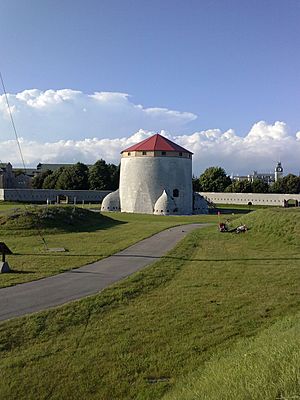
Located east of Kingston's downtown, the army's Camp Barriefield, now McNaughton Barracks, was constructed at the beginning of the World War I and expanded during the World War II. It was named McNaughton Barracks after Andrew George Latta McNaughton, a former minister of national defence. Nearby Vimy Barracks was established in 1937 for the Royal Canadian Corps of Signals. Vimy and McNaughton Barracks house the Canadian Forces School of Communications and Electronics (CFSCE), the Canadian Forces' military communications training centre and several other units.
The Princess of Wales' Own Regiment has been a fixture in the City of Kingston since 1863. The PWOR operates as a Primary Reserve Regiment, its members drawn from the Kingston and area community.
During the First World War, the 21st Battalion was formed and saw action in France in 1915 resulting in 18 battle honours including their role in the Battle of Vimy Ridge. The Royal Canadian Horse Artillery also fought in Europe with the 2nd Canadian Division, taking part in 13 major battles. Fort Henry became an internment camp for enemy aliens from August 1914 to November 1917.
During the Second World War the Stormont, Dundas and Glengarry Highlanders (SD&G), mobilized in June 1940. During fighting, troops that had formed in Kingston received recognition from the government for their achievements. Fort Henry was again an internment camp (Camp 31) from September 1939 to December 1943. A military aerodrome, RCAF Station Kingston, was constructed to the west of Kingston to support flying training.
Heritage sites
Kingston is known for its historic properties. Including World Heritage Sites, National Historic Sites, Provincially Significant sites, municipally designated heritage properties, and listed or non-designated heritage properties, the city has 1211 properties listed in the heritage register.
In 2007, the Rideau Canal, along with the fortifications at Kingston, was designated a World Heritage Site, one of only 15 such sites in Canada.
There are 21 National Historic Sites of Canada in Kingston.
Economy
Kingston's economy relies heavily on public sector institutions and establishments. The most important sectors are related to health care, higher education (Queen's University, the Royal Military College of Canada, and St. Lawrence College), government (including the military and correctional services), tourism and culture.
Manufacturing, and research and development play a smaller role than in the past. One of Kingston's major industrial employers of the 20th century, the Canadian Locomotive Company, closed in 1969, and the former Alcan and DuPont operations employ far fewer people than in the past. But due to the city's central location between Toronto, Ottawa, Montreal and Syracuse, NY a trucking and logistics warehousing industry has developed.
Transportation
Highway 401, which runs in the north part of the city, is the principal access route into Kingston. The first sections of the highway in the Kingston area were opened in 1958, although it was not fully completed for another ten years. Highway 15 is an alternative route between Kingston and the Ottawa region. From the south, Interstate 81 connects with Highway 401 east of Kingston.
Regular ferry service operates between downtown Kingston and Wolfe Island. Seasonal ferry service from Cape Vincent, New York, via Wolfe Island, into downtown Kingston is an alternate route to and from the United States. There are also tourist ferries departing downtown Kingston regularly, although with greater frequency in the summer months.
Via Rail corridor service connects Kingston along the main line between Windsor, Ontario and Quebec City. Kingston is a regular stop on train service operating between Toronto and Ottawa and between Toronto and Montreal.
By air, Kingston is served by Norman Rogers Airport with Air Canada Express providing regular service to Toronto Pearson only.
Megabus (Coach Canada) and Greyhound Canada provide service from the Kingston Bus Terminal to Toronto, Ottawa and Montreal. A Toronto Pearson Airport shuttle is also operated from Kingston via Belleville and Port Hope. Shuttle Kingston was reported in 2013 to connect to Watertown and Syracuse.
Kingston Transit provides local municipal bus service.
Kingston Access Services provides accessible municipal bus service to residents who cannot use Kingston Transit due to disability. In 2017, Kingston Access Services celebrated its 50th anniversary as Ontario's oldest accessible transit service having been established originally as the "Kingston Bus for the Handicapped" in 1967.
Tourism
According to Statistics Canada, the tourism industry in Kingston represents a vital part of the city's economy. In 2004, over 3,500 jobs were contributed to Kingston's economy due to the tourism industry. The tourism industry has been at a healthy growth rate and has become one of the most performing sectors of Kingston. Unique opportunities are presented for this industry in this time of shifting travel trends.
Kingston has launched several tourism campaigns including: Downtown Kingston!, and Yellow Door. The city launched a campaign to attract more traffic to downtown Kingston. The campaigns mission statement promises, "to promote downtown Kingston as the vibrant and healthy commercial, retail, residential, and entertainment centre of our region, attracting more people to live, shop, work and gather". The downtown area of Kingston is known as the central business district, and is the gathering place for various events.
In 2013, Yellow Door received the Tourism Advertising Award of Excellence for the marketing and promotion of an Ontario tourism product.
The following are among the best attractions in and near the city: Canada's Penitentiary Museum, Fort Henry (Fort Henry National Historic Site), Wolfe Island (via ferry), Bellevue House National Historic Site, City Hall and the downtown waterfront nearby. Ontario Travel's recommendations include cruising the Thousand Islands, The Grand Theatre and Leon's Centre.
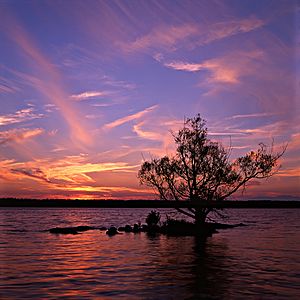
Kingston hosts several festivals during the year, it is home to many artists who work in visual arts, media arts, literature, and a growing number who work in other time-based disciplines such as performance art. The contemporary arts scene in particular has two long standing professional non-profit venues in the downtown area, the Agnes Etherington Art Centre (founded 1957), and Modern Fuel Artist-Run Centre (founded 1977).
The Leon's Centre (renamed from K-Rock Centre) a 5,800-seat entertainment venue and ice rink, opened in February 2008.
Major features of Kingston's waterfront include Flora MacDonald Confederation Basin, Portsmouth Olympic Harbour, Collins Bay, Wolfe Island, Garden Island, the Cataraqui River (including the Inner Harbour and, within that, Anglin Bay).
Education
Kingston is the site of two universities, Queen's University and the Royal Military College of Canada, and a community college, St. Lawrence College. According to Statistics Canada, Kingston has the most PhD-holders per capita of any city in Canada.
Queen's University is one of Canada's oldest universities and offers a variety of degree programs. The university was founded in 1841 under a royal charter from Queen Victoria. It has an enrollment of nearly 25,000 students. Queen's Main Campus is rather self-contained, but is in close walking distance to downtown Kingston, making it a pedestrian friendly university for students and faculty alike.
The Royal Military College of Canada, established in 1876, is Canada's only military university and is a military college), providing academic and leadership training to officer cadets, other members of Canada's armed forces and civilians. There are 1,100 undergraduate students and 500 full and part-time graduate students.
St. Lawrence College offers bachelor's degree programs at its Kingston campus in behavioural psychology, industrial trades, microelectronics, nursing, and business administration, in addition to certificate, diploma, and advanced diploma programs.
The Limestone District School Board serves students in the City of Kingston and the counties of Frontenac and Lennox and Addington. Along with the Limestone School of Community Education, which provides adult education and training programs, approximately 21,000 students attend 70 elementary and secondary schools along with supporting education centres.
The Algonquin and Lakeshore Catholic District School Board serves students of the Roman Catholic faith. Approximately 12,800 students attend 36 elementary schools and 5 secondary schools in this district.
Correctional institutions and facilities
Kingston has the largest concentration of federal correctional facilities in Canada. The facilities are operated by the Correctional Service of Canada. Of the nine institutions in the Kingston area, seven are within the city's municipal boundaries.
- Kingston Penitentiary (maximum security) (closed September 30, 2013)
- Regional Treatment Centre (multi-level security)
- Joyceville Institution (medium security)
- Pittsburgh Institution (minimum security)
- Collins Bay Institution (medium security)
- Frontenac Institution (minimum security),
- Millhaven Institution (maximum security)
- Bath Institution (medium security)
Until 2000, Canada's only federal correctional facility for women, the Prison for Women was also in Kingston, the facility was closed in 2000. Queen's University purchased the property with the intention of renovating it to house the Queen's Archives, but the interior of the building was awarded a heritage designation; therefore, Queen's lost the ability to renovate the interior.
In September 2013, after almost 180 years of housing prisoners, Kingston Penitentiary closed. The maximum security prison was named a National Historic Site of Canada in February 1990 due to its history and reputation. In its early years, the prison had a vital role in constructing the city. The prison brought prosperity to Kingston, and along with eight other prisons being built in the area, helped create an impressive local economy.
Sports
Kingston lays claim to being the birthplace of ice hockey. Kingston is also home to the oldest continuing hockey rivalry in the world by virtue of a game played in 1886 on the frozen Kingston harbour between Queen's University and the Royal Military College of Canada. To mark this event, the city hosts an annual game between the two institutions, played on a cleared patch of frozen lake with both teams wearing period-correct uniforms and using rules from that era. The two schools also contest the annual Carr-Harris Cup, named for Lorne Carr-Harris, under modern competitive conditions to commemorate and continue their rivalry.
The Memorial Cup, which serves as the annual championship event for the Canadian Hockey League, began in 1919 on the initiative of Kingstonian James T. Sutherland. The first championship was held in Kingston. Sutherland, a member of the Hockey Hall of Fame, also helped establish the annual exhibition game between the Royal Military College of Canada and the United States Military Academy (West Point) in 1923.
The International Hockey Hall of Fame, was established in September 1943 with a building constructed in 1965. The International Hockey Hall of Fame, founded by the National Hockey League (NHL) and the Canadian Amateur Hockey Association, is the oldest sports hall of fame in Canada. The museum's collection is home to various items that pay homage to Kingston's role in the history of hockey in Canada.
The city is known for its fresh-water sailing, and hosted the sailing events for the 1976 Summer Olympics. CORK – Canadian Olympic-training Regatta, Kingston – now hosted by CORK/Sail Kingston Inc. is still held every August. Since 1972, Kingston has hosted more than 40 World and Olympic sailing championships. Kingston is listed by a panel of experts among the best yacht racing venues in the US, even though Kingston is in Canada.
During the summers, the RMC campus in Kingston plays host to a Royal Canadian Sea Cadets camp called HMCS Ontario, which provides sail training along with lots of other training to youth from across Canada. The Kingston Yacht Club in downtown Kingston has a learn to sail program for both children and adults.
Kingston is known for fresh-water wreck diving. Kingston's shipwrecks are well preserved by its cool fresh water, and the recent zebra mussel invasion has caused a dramatic improvement in water clarity that has enhanced the quality of diving in the area.
Three curling clubs are in the Kingston area. Kingston has a history of hosting major curling competitions. In 2020, Kingston will host the Tim Hortons Brier, the national men's curling championship. Kingston previously hosted the Brier in 1957. In 2013, Kingston hosted the Scotties Tournament of Hearts, the national women's curling championship.
The Kingston Panthers Rugby Football Club (KPRFC) was founded in 1959, and from that moment onward has established a reputation as a strong community player. The Kingston Panthers R.F.C, recently celebrated their fortieth anniversary.
Images for kids
-
Fort Henry Guard practice drill, Fort Henry
-
Line of defence: three Martello towers (Shoal Tower, Fort Frederick, Cathcart Tower). A fourth tower, Murney Tower, is southwest of this location.
-
Sydenham Street Methodist Church in 1910. It was built in 1852 and later expanded.
-
Royal Military College of Canada robotic sailboat
See also
 In Spanish: Kingston (Ontario) para niños
In Spanish: Kingston (Ontario) para niños



